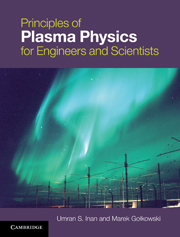Book contents
- Frontmatter
- Contents
- Preface
- 1 Introduction
- 2 Single-particle motion
- 3 Kinetic theory of plasmas
- 4 Moments of the Boltzmann equation
- 5 Multiple-fluid theory of plasmas
- 6 Single-fluid theory of plasmas: magnetohydrodynamics
- 7 Collisions and plasma conductivity
- 8 Plasma diffusion
- 9 Introduction to waves in plasmas
- 10 Waves in cold magnetized plasmas
- 11 Effects of collisions, ions, and finite temperature on waves in magnetized plasmas
- 12 Waves in hot plasmas
- 13 The plasma sheath and the Langmuir probe
- Appendix A Derivation of the second moment of the Boltzmann equation
- Appendix B Useful vector relations
- Index
13 - The plasma sheath and the Langmuir probe
Published online by Cambridge University Press: 05 June 2012
- Frontmatter
- Contents
- Preface
- 1 Introduction
- 2 Single-particle motion
- 3 Kinetic theory of plasmas
- 4 Moments of the Boltzmann equation
- 5 Multiple-fluid theory of plasmas
- 6 Single-fluid theory of plasmas: magnetohydrodynamics
- 7 Collisions and plasma conductivity
- 8 Plasma diffusion
- 9 Introduction to waves in plasmas
- 10 Waves in cold magnetized plasmas
- 11 Effects of collisions, ions, and finite temperature on waves in magnetized plasmas
- 12 Waves in hot plasmas
- 13 The plasma sheath and the Langmuir probe
- Appendix A Derivation of the second moment of the Boltzmann equation
- Appendix B Useful vector relations
- Index
Summary
Introduction
Practical plasmas are typically contained in a vacuum chamber of finite size. When ions and electrons hit the walls, they recombine and are lost. Since electrons have much higher thermal velocities than the ions, one may at first expect that they would be lost faster, leaving the otherwise neutral plasma with a net positive charge. However, because of this tendency, the plasma develops a positive potential with respect to the wall, which prevents most of the electrons from reaching the wall. In equilibrium, a potential gradient arises near the wall so that most of the electrons are reflected back into the plasma, with the number reaching the wall being equal to the corresponding number of positive ions reaching the wall. This potential gradient cannot extend over large sections of the plasma, since Debye shielding (Chapter 1) confines potential variations in a plasma to a layer of the order of several Debye lengths in thickness. This layer of potential gradient, which must exist on all walls with which the plasma is in contact, is called the sheath. Within the sheath, charge neutrality is not preserved, not even approximately, since qΦ changes through the sheath by an amount comparable to kBT. In this chapter, we provide a simple treatment of the formation and structure of the plasma sheath and discuss a simple but very useful device, called the Langmuir probe, which is commonly used to measure electron density and temperature.
- Type
- Chapter
- Information
- Principles of Plasma Physics for Engineers and Scientists , pp. 251 - 260Publisher: Cambridge University PressPrint publication year: 2010

